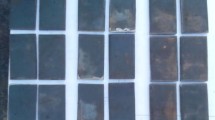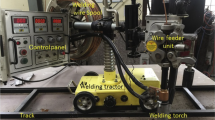Abstract
Taguchi philosophy has been applied for obtaining optimal parametric combinations to achieve desired weld bead geometry and dimensions related to the heat-affected zone (HAZ), such as HAZ width in the present case, in submerged arc welding. The philosophy and methodology proposed by Dr. Genichi Taguchi can be used for continuous improvement in products that are produced by submerged arc welding. This approach highlights the causes of poor quality, which can be eliminated by self-adjustment among the values of the process variables if they tend to change during the process. Depending on functional requirements of the welded joint, an acceptable weldment should confirm maximum penetration, minimum reinforcement, minimum bead width, minimum HAZ width, minimum bead volume, etc. to suit its area of application. Hence, there exists an increasing demand to evaluate an optimal parameter setting that would fetch the desired yield. This could be achieved by optimization of welding variables. Based on Taguchi’s approach, the present study has been aimed at integrating statistical techniques into the engineering process. Taguchi’s L9 (3**3) orthogonal array design has been adopted and experiments have been accordingly conducted with three different levels of conventional process parameters using welding current and flux basicity index to obtain bead-on-plate weld on mild steel plates. Features of bead geometry and HAZ in terms of bead width, reinforcement, depth of penetration and HAZ width have been measured for each experimental run. The slag, generated during welding, has been consumed in further runs by mixing it with fresh unmelted flux. The percentage of slag in the mixture of fused flux (slag) and fresh flux has been defined as slag-mix%. Welding has been performed by using varying slag-mix%, treated as another process variable, in order to obtain the optimum amount of slag-mix that can be used without any alarming adverse effect on features of bead geometry and HAZ. This would lead to ‘waste to wealth’.
Similar content being viewed by others
References
Gunaraj V, Murugan N (2000) Prediction and optimization of weld bead volume for the submerged arc process—part 1. Weld Res Suppl 286–294
Gunaraj V, Murugan N (2000) Prediction and optimization of weld bead volume for the submerged arc process—part 2. Weld Res Suppl 331–338
Kim IS, Son JS, Park CE, Kim IJ, Kim HH (2005) An investigation into an intelligent system for predicting bead geometry in GMA welding process. J Mater Process Technol 159:113–118
Tarng YS, Juang SC, Chang CH (2002) The use of grey-based Taguchi methods to determine submerged arc welding process parameters in hardfacing. J Mater Process Technol 128:1–6
Maghsoodloo S, Ozdemir G, Jordan V, Huang C-H (2004) Strengths and limitations of Taguchi’s contributions to quality, manufacturing, and process engineering. J Manuf Syst 23(2):73–126
Gunaraj V, Murugan N (1999) Application of response surface methodology for predicting weld bead quality in submerged arc welding of pipes. J Mater Process Technol 88:266–275
Beck HP, Jackson AR (1996) Recycling of SAW slag proves reliable and repeatable. Weld J 75(6):51–54
Antony J, Antony F (2001) Teaching the Taguchi method to industrial engineers. Work Study 50(4):141–149
Rowlands H, Antony J, Knowles G (2000) An application of experimental design for process optimization. The TQM Magazine 12(2):78–83
Sang-Heon L, Choon-Man L, Won Jee C (2006) A study on the optimal cutting condition of a high speed feeding type laser cutting machine by using Taguchi method. Int J Precis Eng Manuf 7(1):18–23
Unal R, Dean Edwin B (1991) Taguchi approach to design optimization for quality and cost: an overview. Presented at the 13th annual conference of the international society of parametric analysis, New Orleans, LA, 21–24 May
Yang WH, Tarng YS (1998) Design optimization of cutting parameters for turing operations based on the Taguchi method. J Mater Process Technol 84:122–129
Nalbant M, Gökkaya H, Sur G (2006) Application of Taguchi method in the optimization of cutting parameters for surface roughness in turning. Mater Des (in press)
Davis OL (1978) Design and analysis of industrial experiments. Longman, New York
Minitab, Inc. (2000) MINITAB release 13.1, user’s manual. Minitab, Inc., State College, PA, USA
Author information
Authors and Affiliations
Corresponding author
Rights and permissions
About this article
Cite this article
Datta, S., Bandyopadhyay, A. & Pal, P.K. Application of Taguchi philosophy for parametric optimization of bead geometry and HAZ width in submerged arc welding using a mixture of fresh flux and fused flux. Int J Adv Manuf Technol 36, 689–698 (2008). https://doi.org/10.1007/s00170-006-0894-7
Received:
Accepted:
Published:
Issue Date:
DOI: https://doi.org/10.1007/s00170-006-0894-7




